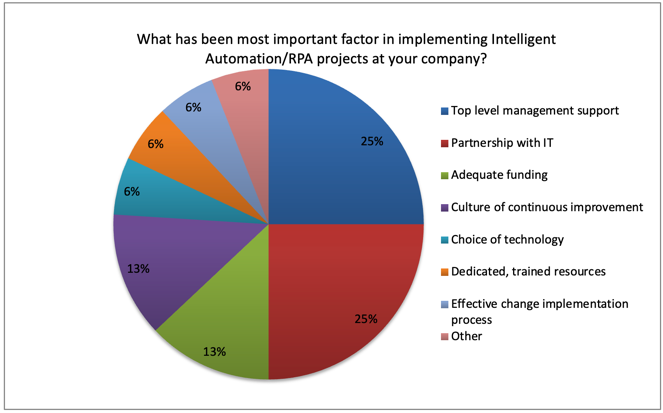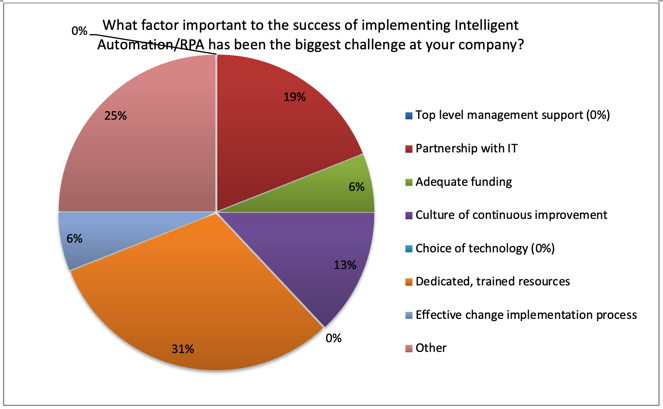Merging a Successful RPA Program with an SAP S/4 HANA Implementation
Merging a Successful RPA Program with an SAP S/4 HANA Implementation
Introduction
The global implementation of SAP S4/HANA is a monumental effort, requiring the close coordination of process experts and technology teams across all geographies. Because of the nature of the upgrade that includes real-time processing and many enhanced capabilities, it requires a detailed review of all Intelligent Automation efforts. Successfully merging completed RPA projects with an S/4 HANA rollout, and establishing processes for new RPA projects, takes close coordination the S/4 HANA project team.
Company Experiences
A Peercast featured a global company with $12B in annual revenue discussing their approach to merging a successful RPA program with their SAP S/4 HANA implementation. This merging included turning off RPA functionality that was now integrated into S/4 HANA, updating existing RPA projects to integrate with the new systems environment, and new automations performed after the systems implementation was completed.
The journey for process automation at the company started in 2016 using Blue Prism, the RPA solution selected and currently in place. The first projects were live in 2017, with the scope of the projects shifting to include the total enterprise with an emphasis on supply chain and finance related projects. RPA project team are part of a Center of Excellence that is part of Global Business Services, reporting up through the Information Systems organization. The team works closely with Invoke, a 3rd party support and development company, in addition to having six full-time automation developers, a business analyst, and an Intelligent Automation manager who are company employees.
The discussion included a walk-through of the operating model for S4 and Business Process Automation, including a Discovery phase where the S4 and RPA team collaborates to validate and identify requirements; a Build phase that includes design & test and implementation; and a Govern phase that includes hyper-care support to monitor processes for a period of time followed by normal support efforts to maintain processes and evaluate them for ongoing improvement opportunities.
Polling Results Review
Peeriosity-100 Polling was used to understand the most important factors for implementing Intelligent Automation/RPA projects at member companies. The most important factors cited by half of responding companies were top level management support (25%) and partnership with IT (25%). An additional 26% were evenly split between adequate funding (13%) and culture of continuous improvement (13%). Here are the details:

The second poll question used the same response options to better understand which factors have been the biggest challenge. For 31% of responding companies, the biggest challenge was having dedicated, trained resources. While no company cited top level management support as the biggest challenge, 19% cited partnership with IT, and 13% cited having a culture of continuous improvement.

Here are some comments from responding companies:
- The result has been less automated than originally promised with new types of fall out happening that needs to be resolved.
- Adequate IT resources is what causes delays in implementing new technologies.
- IT resources are key to any automation project, so full alignment is needed for successful implementation.
- Comments are based on perception’s as we have not yet fully engaged in RPA but are keen to progress.
- Having a limited number of employees to do development creates bottlenecks.
- We find that people that are responsible for automation do not understand the business processes well enough.
- Internal gating processes for approval (~33% of build cost) is a problem for us.
Closing Summary
Creating and maintaining a successful RPA program, and successfully implementing SAP S/4 HANA, are both technology related initiatives that can have a huge impact on both Shared Services/GBS and the entire enterprise, touching many if not all parts of the company. With design, implementation, and support issues for both RPA and S/4 HANA that overlap, with many dependencies and co-dependencies, close coordination is necessary to ensure the benefits of robust RPA solutions can be effectively included as a part of the transition to S/4 HANA.
If your company is on SAP and implementing S/4 HANA, how are your coordinating this major change initiative with your RPA program?
Who are your peers and how are you collaborating with them?
______________________________________________________________________________
Peercasts are private, professionally facilitated webcasts that feature leading member company experiences on specific topics as a catalyst for broader discussion. Access is available exclusively to Peeriosity-100 member company employees, with consultants or vendors prohibited from attending or accessing discussion content. Members can see who is registered to attend in advance, with discussion recordings, supporting polls, and presentation materials online and available whenever convenient for the member. Using Peeriosity-100’s integrated email system, Peer Mail, attendees can easily communicate at any time with other attending peers by selecting them from the list of registered attendees.
Polling is available exclusively to Peeriosity-100 member company employees, with consultants or vendors prohibited from participating or accessing content. Members have full visibility to all respondents and their comments. Using Peeriosity-100’s integrated email system, Peer Mail, members can easily communicate at any time with others who participated in Polling.

